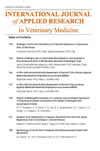叶绿醇对尼罗罗非鱼淡毒弧菌感染的抑菌活性评价
4区 农林科学
Q4 Veterinary
International Journal of Applied Research in Veterinary Medicine
Pub Date : 2021-09-01
DOI:10.52547/injvr.1.1.9
引用次数: 0
摘要
目前,约50%的渔业由水产养殖支撑,水产养殖是世界上发展最快的粮食生产部门之一。虽然捕鱼业的捕捞量明显下降,但全球对鱼类的需求却在增加,这使其成为可持续发展的业务,成为世界上的头等大事。水产养殖业疾病暴发,特别是由鱼丹毒等细菌引起的疾病暴发,是盈利能力的重大障碍。由于抗生素费用高昂,它们提供的保护时间有限,在长期疾病暴发期间必须重复治疗,耐药菌株带来的挑战,以及尸体中有害残留物的水平不断上升,因此不鼓励使用抗生素。作为替代,植物化学物质如叶绿醇可以被使用。本研究观察了经植物素灌胃的尼罗罗非鱼(Oreochromis niloticus)的血清学、生物化学、免疫学、抗氧化剂、组织病理学和寿命,这些罗非鱼感染了pisciscicarius。将E. pisciscicarius (1.4 x10 CFU/mL/g)腹腔注射于平均体重4.22g的尼罗罗非鱼幼鱼(n=120)体内,然后将其分成12个1m 3的鱼缸。每个鱼缸里养了10条鱼。感染24小时后分别用0、1.75、3.50、7.00 mg/g的叶绿醇溶液灌胃,观察14天的临床变化。结果表明,在感染后的前三天,鱼的身体没有发生物理变化。然而,在第4天,在对照组和1.75 mg/g的情况下,鱼的头部区域都出现了裂缝,在第10天,鱼的鱼盖周围的微弱血迹变得更加明显。2.50 mg/g叶绿醇灌胃组成活率最高(60.0%),对照组最低(20.0%)。鱼的PCV、血红蛋白、Heterocytes、RBC、WBC、血小板、淋巴细胞、MCH、MCHC和Hetero Lymphocyte均以对照组最低,差异有统计学意义(P < 0.05)。经叶绿醇灌胃的鱼的超氧化物歧化酶、过氧化氢酶、溶菌酶和呼吸爆发活性显著高于对照组。对照组表现为隐窝和表面肠细胞坏死,肠绒毛萎缩和鳃片增生,而治疗组,特别是在3.50至7.00 mg/g叶绿醇剂量下,仅表现为轻度至无病变。研究表明,感染淡化鱼丹毒对尼罗罗非鱼的生存、血液学、抗氧化剂和免疫力有显著影响。在3.21毫克/克的推荐水平下,叶绿醇还可用于治疗和控制尼罗罗非鱼的淡化病感染。本文章由计算机程序翻译,如有差异,请以英文原文为准。
Evaluation of the anti-bacterial activity of phytol against Erysipelothrix piscisicarius infection in Nile tilapia (Oreochromis niloticus)
About 50% of fisheries are now supported by aquaculture, one of the world's fastest expanding food producing sectors. While there has been a clear decline in catch fisheries, there has been an increase in the global demand for fish, making it a sustainable business and top priority in the world. Aquaculture disease outbreaks, particularly those caused by bacteria like Erysipelothrix piscisicarius , are a significant barrier to profitability. Due to the high expense of antibiotics, the limited duration of protection they provided, the necessity for repeated treatments during prolonged disease outbreaks, the challenges posed by resistant strains, and the rising levels of hazardous residues in carcasses, the use of antibiotics has been discouraged. As an alternative, phytochemicals like phytol can be employed. This investigation looked at the haematology, biochemistry, immunological profiles, antioxidants, histopathology, and lifespan of Phytol-gavaged Nile tilapia, Oreochromis niloticus , which had been infected with E. pisciscicarius . E. pisciscicarius (1.4 x10 CFU/mL/g) was intraperitoneally injected into juvenile Nile tilapia (n=120, mean weight= 4.22g) before being divided among 12 1m 3 tanks. Ten fish were housed in each tank. The fish were gavaged with phytol solution at 0, 1.75, 3.50, or 7.00 mg/g after 24 hours of infection, and 14 days' worth of clinical changes were monitored. The outcomes demonstrated that for the first three days after infection, the fish's body did not physically change. However, on Day 4, cracks were seen on the fish's head region in both the Control and 1.75 mg/g, and on Day 10, weak traces of blood surrounding the operculum of the fish grew more obvious. The fish gavaged with 2.50 mg/g phytol experienced the highest survival rate (60.0%), while the control group experienced the lowest (20.0%). With their lowest values found in the control group, significant differences were found in PCV, Haemoglobin, Heterocytes, RBC, WBC, Platelets, Lymphocytes, MCH, MCHC, and Hetero:Lymphocyte in fish (P 0.05). Fish gavaged with phytol had significantly higher superoxide dismutase, catalase, lysozyme, and respiratory burst activity than the control. The control group showed cryptal and surface enterocyte necrosis, intestinal villi atrophy, and gill lamellae hyperplasia, while the treated group, particularly at doses of 3.50 to 7.00 mg/g phytol, showed only mild to no lesions. The study came to the conclusion that Erysipelothrix pisciscicarius infection has a significant impact on Nile tilapia survival, haematology, antioxidants, and immunity. At the recommended level of 3.21 mg/g, phytol can also be used to treat and control the Erysipelothrix pisciscicarius infection in Nile tilapia.
求助全文
通过发布文献求助,成功后即可免费获取论文全文。
去求助
来源期刊
自引率
0.00%
发文量
1
审稿时长
3 months
期刊介绍:
The International Journal of Applied Research in Veterinary Medicine promotes excellence in the clinical practice of veterinary medicine by disseminating fundamental scientific, diagnostic, and treatment knowledge gained from prospective and retrospective research in a timely manner. The Journal fulfills its mission through rapid peer review of each submitted article, and publication of all articles within 90 days of acceptance. All published articles meet the standards of Balance, Independence, Objectivity and Scientific Rigor.

 求助内容:
求助内容: 应助结果提醒方式:
应助结果提醒方式:


